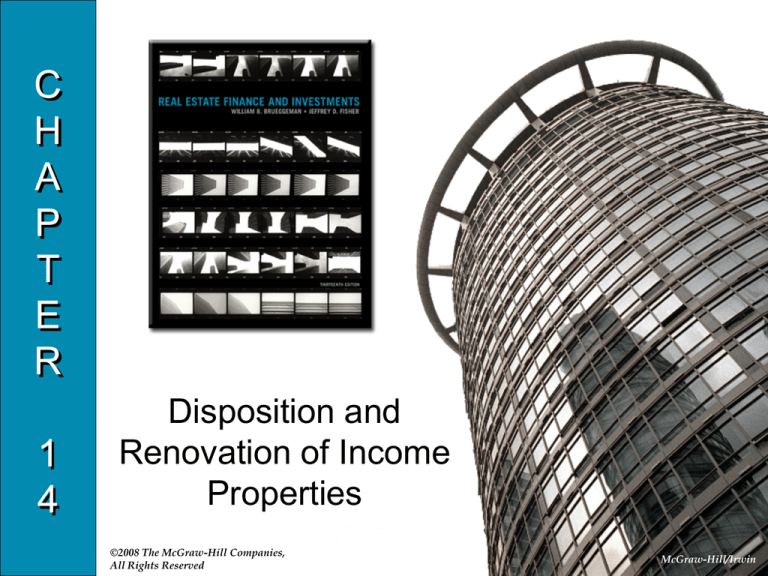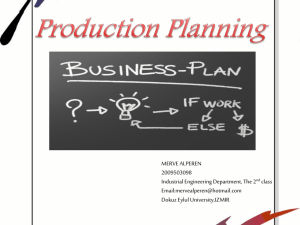
C
H
A
P
T
E
R
1
4
Disposition and
Renovation of Income
Properties
©2008 The McGraw-Hill Companies,
All Rights Reserved
McGraw-Hill/Irwin
Disposition Decisions
• Disposition Consideration
Changes in expectations over an anticipated
holding period
• Market rent problems
• Tax law changes
Equity build-up
• Opportunity Cost of not selling the property
• Reduced interest payments and lower tax
deduction
14-2
Copyright ©2008 by The McGraw-Hill Companies, Inc. All Rights Reserved
Disposition Decisions
• Decision Rule: Property Disposition
What can the investor net if the property is
sold today?
What is the future expected performance of
the property for the current investor if not
sold?
Should the property be sold and the funds
invested in another property?
14-3
Copyright ©2008 by The McGraw-Hill Companies, Inc. All Rights Reserved
Disposition Decisions
• Expected cash flows are adjusted for
current expectations
New rental income growth rate assumptions
Original cost and depreciation stay in place
Tax rates change to reflect current laws
Mortgage and interest stay the same
What is the expected future sale price of the
property?
14-4
Copyright ©2008 by The McGraw-Hill Companies, Inc. All Rights Reserved
Disposition Decisions
• If the investor will net $100,000 after all
taxes and expenses if the property is sold
today…
Can it be invested and earn a greater return
than if the property is not sold?
The investor gives up the following cash flow
stream by selling the property….
14-5
Copyright ©2008 by The McGraw-Hill Companies, Inc. All Rights Reserved
Disposition Decisions
• The future expected net cash flows for a
three-year holding period are
ATCF0 = ($100,000)
ATCF1 = $10,000
ATCF2 = $11,000
ATCF3 = $12,000
ATCF3(sale) = $103,000
Compute IRR = 11.82%
14-6
Copyright ©2008 by The McGraw-Hill Companies, Inc. All Rights Reserved
Disposition Decisions
• The ATIRR = 11.82% is what the investor
gives up by selling the property and taking
$100,000 today.
• Is there an equivalent risk investment that
can earn a greater ATIRR?
If yes, sale is justified
If not, property should be kept.
14-7
Copyright ©2008 by The McGraw-Hill Companies, Inc. All Rights Reserved
Disposition Decisions
• Return to a New Investor
New investor has a new adjusted basis in the
property
New investor depreciates the property based
on current tax law
• What can a new investor earn given the
changes?
Compute an ATIRR for the new investor
14-8
Copyright ©2008 by The McGraw-Hill Companies, Inc. All Rights Reserved
Disposition Decisions
• Marginal Rate of Return
Property Disposition:
• Evaluate disposition for a one-year holding period
• Repeat the evaluation for subsequent one-year
holding periods
• This generates a series of marginal returns based
on one-year holding periods
14-9
Copyright ©2008 by The McGraw-Hill Companies, Inc. All Rights Reserved
Disposition Decisions
• Marginal Rate of Return
Disposition Rule:
• Sell when MRR falls below assumed reinvestment
rate for funds from property sale
• Optimal holding period
Reinvestment Rate:
• Constant or rising
• Should reflect market rates and return on
alternative investments
14-10
Copyright ©2008 by The McGraw-Hill Companies, Inc. All Rights Reserved
Disposition Decisions
• Refinancing as an Alternative
Increase the current LTV ratio by refinancing
• Provides additional funds to invest
Incremental cost of refinancing
• What are the additional funds obtained by
refinancing?
• What are the additional cash outflows?
• Solve for i: can this be earned or borrowed funds?
Diversification benefits
14-11
Copyright ©2008 by The McGraw-Hill Companies, Inc. All Rights Reserved
Disposition Decisions
• Renovation as an alternative
What are economic trends?
• Is property improvement justified?
Enlarged or quality upgraded
• Should it be converted?
Alternative use to reflect market changes
What is the renovation cost?
• Does it require additional equity?
• What are available financing sources?
14-12
Copyright ©2008 by The McGraw-Hill Companies, Inc. All Rights Reserved
Disposition Decisions
• Renovation as an alternative
Calculate the incremental change in the
expected future operating cash flows.
Calculate the incremental change in the future
expected selling price of the property.
Determine the IRR on the additional equity
investment.
Compare the IRR to alternative equivalent risk
investments.
14-13
Copyright ©2008 by The McGraw-Hill Companies, Inc. All Rights Reserved
Disposition Decisions
• Additional Considerations
Combined renovation and refinancing
Portfolio balancing
Rehabilitation Investment Tax Credits
• Dollar for dollar reduction in taxes
Low-income Housing
• Tax Reform Act of 1986
14-14
Copyright ©2008 by The McGraw-Hill Companies, Inc. All Rights Reserved





